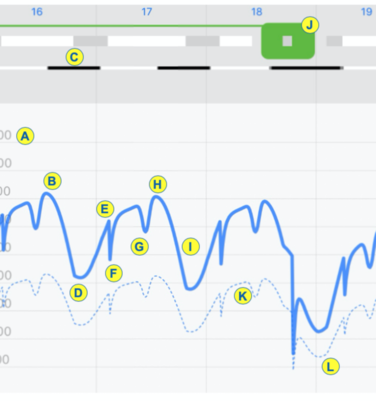
FRM News Flash – April 2020
Special Additions on Fatigue Modeling
With the industry still very much in flux, disrupted by the COV ID-19 pandemic, we are taking the opportunity to dedicate a couple of issues of this news flash to ‘deep dive’ into the wonderful world of fatigue risk modelling. We will interview experts, provide links to further documentation and articles, and hopefully convey new insights into different mechanisms and use cases for these fatigue prediction models. We will do so on a general level, but of course foremost with the Boeing Alertness Model in mind.
ID-19 pandemic, we are taking the opportunity to dedicate a couple of issues of this news flash to ‘deep dive’ into the wonderful world of fatigue risk modelling. We will interview experts, provide links to further documentation and articles, and hopefully convey new insights into different mechanisms and use cases for these fatigue prediction models. We will do so on a general level, but of course foremost with the Boeing Alertness Model in mind.
Free Copy of CrewAlert Pro for Flight Safety Professionals
 Many of us now have a bit of extra time on our hands, and for some it could be a good opportunity to learn more about fatigue models and available tools for FRM. For airline flight safety professionals, we are therefore, for a limited time only, giving away a large number of licenses to CrewAlert Pro free of charge. Please just register your interest via this link and within a few days we will provide you with details for how to download the application. Please note that CrewAlert Pro requires an iOS device; an iPad or an iPhone.
Many of us now have a bit of extra time on our hands, and for some it could be a good opportunity to learn more about fatigue models and available tools for FRM. For airline flight safety professionals, we are therefore, for a limited time only, giving away a large number of licenses to CrewAlert Pro free of charge. Please just register your interest via this link and within a few days we will provide you with details for how to download the application. Please note that CrewAlert Pro requires an iOS device; an iPad or an iPhone.
CrewAlert Pro is the go-to app for aviation fatigue risk management and has the Boeing Alertness Model built-in and a wide set of powerful features as can be seen in this ‘cheat sheet‘.
Special Jeppesen Operations During COVID-19 Pandemic

As the COVID-19 pandemic continues to severely impact the aviation industry, for Jeppesen the operation is also far from normal. Some unusual, pandemic-related, activities we have recently been engaged in are:
- Assisting operators to plan crew more in teams, reducing the impact in case they become infected
- Providing advice and guidance for fast and frequent re-planning using the optimizers when preconditions change at short notice
- Investigating usage of our crew rostering optimization capabilities for assisting the health care sector to produce rosters for personnel caring for COVID-19 patients
- Providing advice to operators about re-configuration of fatigue model functionality and crew planning optimizers for utilizing/following current and proposed regulatory guidance for managing the crew during the pandemic
- Special operations, like repatriation flights, being modelled and assessed for fatigue risk using BAM, as requested by regulators when operating ‘beyond’ the normal flight and duty time limits
Please contact your Jeppesen representative or service manager if you think we may be of assistance also to your operation during these special conditions.
Reading the Predictions from a Fatigue Model
 Reading a prediction from a fatigue model is not always that straightforward. There are circadian rhythms, sleep inertia processes, effects from long hours of wakefulness, and plenty of other components contributing to a prediction.
Reading a prediction from a fatigue model is not always that straightforward. There are circadian rhythms, sleep inertia processes, effects from long hours of wakefulness, and plenty of other components contributing to a prediction.
Please find in this document a more detailed description of what you are looking at when you study the prediction coming from the Boeing Alertness Model.
A Sneak Peek at the Development of BAM 3 (Part 1)
BAM version 3 is in the final stages of testing and we managed to get an interview with the mastermind behind much of the modelling and validation that has gone into the new version; David Karlsson, Senior Mathematical Fatigue Risk Modelling Specialist at Jeppesen.
David, what can we expect from BAM 3, and when will we see this new release ‘in action’?
– You should expect the same high performance  as in BAM 2, a somewhat softer sleep prediction, improved modelling of task load, and improved sleep prediction in large time-zone transitions when physiology clashes with society. You will also find a novel approach for the modelling of acclimatization, which reduces the dependency on time zones and instead leans more heavily on light exposure. You can also expect the same leading validation methodology to be used as for BAM 2, but now using much more data.
as in BAM 2, a somewhat softer sleep prediction, improved modelling of task load, and improved sleep prediction in large time-zone transitions when physiology clashes with society. You will also find a novel approach for the modelling of acclimatization, which reduces the dependency on time zones and instead leans more heavily on light exposure. You can also expect the same leading validation methodology to be used as for BAM 2, but now using much more data.
Wow, that was quite a lot. Can you tell me more about the validation efforts? And again; when can we expect to start using this new release?
– Naturally, validation is of key importance in this work. The updated model must not only match collected actuals on an overall improved level, but also with good margin ‘defend’ the increased complexity when adding new mechanisms to the model. Jeppesen has today, I dare say, more collected fatigue data of high-quality than any other organisation, making these large-scale data-driven improvements quite viable – although not in any way simple. We need to be careful to neither over-inform, nor overfit the model to the collected data, and also ensure validation is done on data not being part of ‘training’ the model in the first place. A good methodology is already there, through our earlier work, which we are now piggy-backing on. When improving BAM we are in part using purpose-built parameter optimization software for identifying the best combination of settings for the internal model parameters in huge optimization jobs. What mainly remains now is to also double-check against predictions from BAM 2 on large sets of customer data and work sequences out of our pattern generator.
What do you mean by a pattern generator? And please, when will BAM 3 be released?
– Our pattern generator is a tool that produces an extreme amount, tens of millions, of airline-relevant crew scheduling patterns of generic nature such as combinations of early and late duties, but also patterns crossing time zones in a lot of different timing combinations with and without augmented crew etc. We are using this generator for ‘regression tests’ between model versions, with particular interest of course in the patterns that predicts quite differently between them. So far the results, also here, are very encouraging.
Thank you David. We will try to squeeze you for a few additional answers and some more details regarding the above in a coming issue of this newsletter. Hopefully also a prediction graph illustrating some differences between BAM 2 and 3. And possibly a date?
– OK. Let’s see about that.
jeppesen.com/frm
+46 31 720 81 00
Send us an Email
Special Additions on Fatigue Modeling
With the industry still very much in flux, disrupted by the COV ID-19 pandemic, we are taking the opportunity to dedicate a couple of issues of this news flash to ‘deep dive’ into the wonderful world of fatigue risk modelling. We will interview experts, provide links to further documentation and articles, and hopefully convey new insights into different mechanisms and use cases for these fatigue prediction models. We will do so on a general level, but of course foremost with the Boeing Alertness Model in mind.
ID-19 pandemic, we are taking the opportunity to dedicate a couple of issues of this news flash to ‘deep dive’ into the wonderful world of fatigue risk modelling. We will interview experts, provide links to further documentation and articles, and hopefully convey new insights into different mechanisms and use cases for these fatigue prediction models. We will do so on a general level, but of course foremost with the Boeing Alertness Model in mind.
Free Copy of CrewAlert Pro for Flight Safety Professionals
 Many of us now have a bit of extra time on our hands, and for some it could be a good opportunity to learn more about fatigue models and available tools for FRM. For airline flight safety professionals, we are therefore, for a limited time only, giving away a large number of licenses to CrewAlert Pro free of charge. Please just register your interest via this link and within a few days we will provide you with details for how to download the application. Please note that CrewAlert Pro requires an iOS device; an iPad or an iPhone.
Many of us now have a bit of extra time on our hands, and for some it could be a good opportunity to learn more about fatigue models and available tools for FRM. For airline flight safety professionals, we are therefore, for a limited time only, giving away a large number of licenses to CrewAlert Pro free of charge. Please just register your interest via this link and within a few days we will provide you with details for how to download the application. Please note that CrewAlert Pro requires an iOS device; an iPad or an iPhone.
CrewAlert Pro is the go-to app for aviation fatigue risk management and has the Boeing Alertness Model built-in and a wide set of powerful features as can be seen in this ‘cheat sheet‘.
Special Jeppesen Operations During COVID-19 Pandemic

As the COVID-19 pandemic continues to severely impact the aviation industry, for Jeppesen the operation is also far from normal. Some unusual, pandemic-related, activities we have recently been engaged in are:
- Assisting operators to plan crew more in teams, reducing the impact in case they become infected
- Providing advice and guidance for fast and frequent re-planning using the optimizers when preconditions change at short notice
- Investigating usage of our crew rostering optimization capabilities for assisting the health care sector to produce rosters for personnel caring for COVID-19 patients
- Providing advice to operators about re-configuration of fatigue model functionality and crew planning optimizers for utilizing/following current and proposed regulatory guidance for managing the crew during the pandemic
- Special operations, like repatriation flights, being modelled and assessed for fatigue risk using BAM, as requested by regulators when operating ‘beyond’ the normal flight and duty time limits
Please contact your Jeppesen representative or service manager if you think we may be of assistance also to your operation during these special conditions.
Reading the Predictions from a Fatigue Model
 Reading a prediction from a fatigue model is not always that straightforward. There are circadian rhythms, sleep inertia processes, effects from long hours of wakefulness, and plenty of other components contributing to a prediction.
Reading a prediction from a fatigue model is not always that straightforward. There are circadian rhythms, sleep inertia processes, effects from long hours of wakefulness, and plenty of other components contributing to a prediction.
Please find in this document a more detailed description of what you are looking at when you study the prediction coming from the Boeing Alertness Model.
A Sneak Peek at the Development of BAM 3 (Part 1)
BAM version 3 is in the final stages of testing and we managed to get an interview with the mastermind behind much of the modelling and validation that has gone into the new version; David Karlsson, Senior Mathematical Fatigue Risk Modelling Specialist at Jeppesen.
David, what can we expect from BAM 3, and when will we see this new release ‘in action’?
– You should expect the same high performance  as in BAM 2, a somewhat softer sleep prediction, improved modelling of task load, and improved sleep prediction in large time-zone transitions when physiology clashes with society. You will also find a novel approach for the modelling of acclimatization, which reduces the dependency on time zones and instead leans more heavily on light exposure. You can also expect the same leading validation methodology to be used as for BAM 2, but now using much more data.
as in BAM 2, a somewhat softer sleep prediction, improved modelling of task load, and improved sleep prediction in large time-zone transitions when physiology clashes with society. You will also find a novel approach for the modelling of acclimatization, which reduces the dependency on time zones and instead leans more heavily on light exposure. You can also expect the same leading validation methodology to be used as for BAM 2, but now using much more data.
Wow, that was quite a lot. Can you tell me more about the validation efforts? And again; when can we expect to start using this new release?
– Naturally, validation is of key importance in this work. The updated model must not only match collected actuals on an overall improved level, but also with good margin ‘defend’ the increased complexity when adding new mechanisms to the model. Jeppesen has today, I dare say, more collected fatigue data of high-quality than any other organisation, making these large-scale data-driven improvements quite viable – although not in any way simple. We need to be careful to neither over-inform, nor overfit the model to the collected data, and also ensure validation is done on data not being part of ‘training’ the model in the first place. A good methodology is already there, through our earlier work, which we are now piggy-backing on. When improving BAM we are in part using purpose-built parameter optimization software for identifying the best combination of settings for the internal model parameters in huge optimization jobs. What mainly remains now is to also double-check against predictions from BAM 2 on large sets of customer data and work sequences out of our pattern generator.
What do you mean by a pattern generator? And please, when will BAM 3 be released?
– Our pattern generator is a tool that produces an extreme amount, tens of millions, of airline-relevant crew scheduling patterns of generic nature such as combinations of early and late duties, but also patterns crossing time zones in a lot of different timing combinations with and without augmented crew etc. We are using this generator for ‘regression tests’ between model versions, with particular interest of course in the patterns that predicts quite differently between them. So far the results, also here, are very encouraging.
Thank you David. We will try to squeeze you for a few additional answers and some more details regarding the above in a coming issue of this newsletter. Hopefully also a prediction graph illustrating some differences between BAM 2 and 3. And possibly a date?
– OK. Let’s see about that.
| jeppesen.com/frm | +46 31 720 81 00 | Send us an Email |